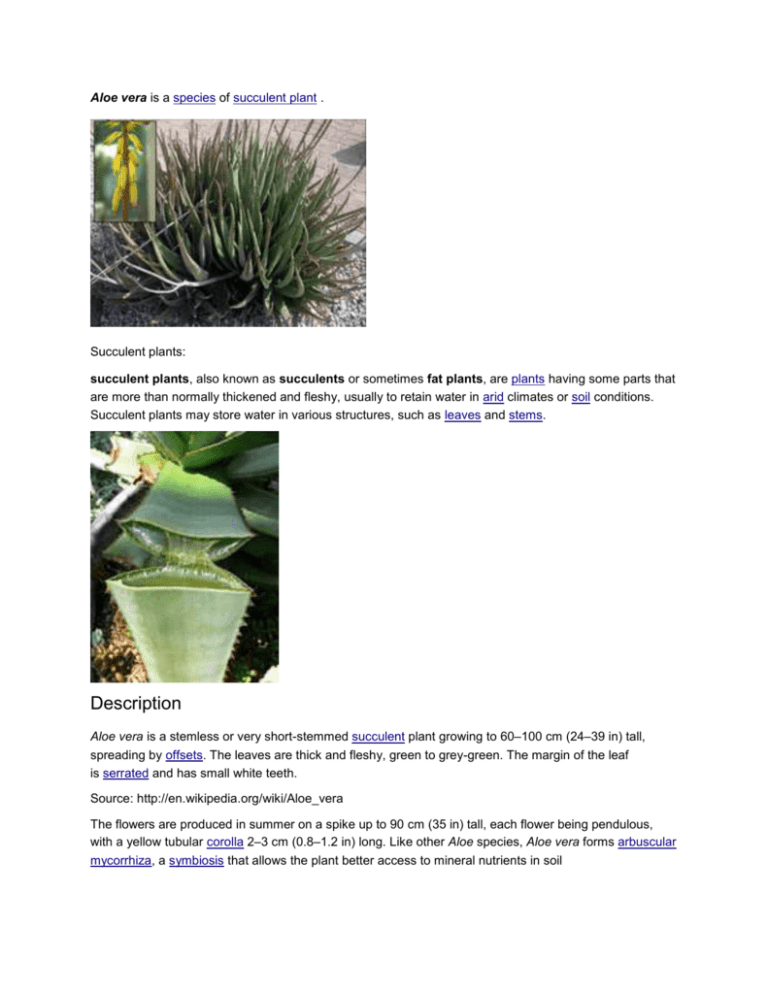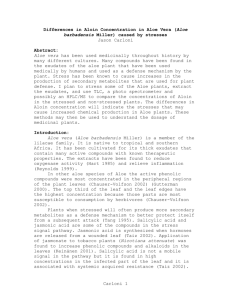Aloe vera - Reach Out To Asia
advertisement

Aloe vera is a species of succulent plant . Succulent plants: succulent plants, also known as succulents or sometimes fat plants, are plants having some parts that are more than normally thickened and fleshy, usually to retain water in arid climates or soil conditions. Succulent plants may store water in various structures, such as leaves and stems. Description Aloe vera is a stemless or very short-stemmed succulent plant growing to 60–100 cm (24–39 in) tall, spreading by offsets. The leaves are thick and fleshy, green to grey-green. The margin of the leaf is serrated and has small white teeth. Source: http://en.wikipedia.org/wiki/Aloe_vera The flowers are produced in summer on a spike up to 90 cm (35 in) tall, each flower being pendulous, with a yellow tubular corolla 2–3 cm (0.8–1.2 in) long. Like other Aloe species, Aloe vera forms arbuscular mycorrhiza, a symbiosis that allows the plant better access to mineral nutrients in soil Techniques based on DNA comparison suggest that Aloe vera is relatively closely related to Aloe perryi, a species that is endemic to Yemen.[20] Similar techniques, using chloroplast DNA sequence comparison and ISSR profiling have also suggested that Aloe vera is closely related to Aloe forbesii, Aloe inermis, Aloe scobinifolia, Aloe sinkatana, and Aloe striata.[21] With the exception of the South African species A. striata, these Aloe species are native toSocotra (Yemen), Somalia, and Sudan.[21] The lack of obvious natural populations of the species have led some authors to suggest that Aloe vera may be of hybrid origin Uses Scientific evidence for the cosmetic and therapeutic effectiveness of aloe vera is limited and when present is frequently contradictory. Despite this, the cosmetic and alternative medicine industries regularly make claims regarding the soothing, moisturizing, and healing properties of aloe vera. Aloe vera gel is used as an ingredient in commercially available lotions, yogurt, beverages, and some desserts, although at certain doses, it has toxic properties when used either for ingested or topical applications Dietary supplement Aloin, a compound found in the exudate of some Aloe species, was the common ingredient in over-thecounter (OTC) laxative products in the United States prior to 2003, when the Food and Drug Administration ruled that aloin was a class III ingredient, thereby banning its use. Although toxicity may be less when aloin is removed by processing, aloe vera that contains aloin in excess amounts may induce side-effects. A 2-year National Toxicology Program (NTP) study on oral consumption of non-decolorized whole leaf extract of Aloe vera found evidence of carcinogenic activity in male and female rats. The NTP says more information is needed to determine the potential risks to humans.[45][46][47] Aloe vera juice is marketed to support the health of the digestive system, but there is neither scientific evidence nor regulatory approval to support this claim. The extracts and quantities typically used for such purposes appear to be dose-dependent for toxic effects. Phytochemicals Aloe vera leaves contain phytochemicals under study for possible bioactivity, such as acetylated mannans, polymannans, anthraquinone C-glycosides, anthrones, anthraquinones, such asemodin, and various lectins. Some of these compounds are used to manufacture insecticides. Commodities Aloe vera is now widely used on facial tissues, where it is promoted as a moisturiser and/or anti-irritant to reduce chafing of the nose of users suffering hay-fever or cold. It is common practice for cosmetic companies to add sap or other derivatives from Aloe vera to products such as makeup, tissues, moisturizers, soaps, sunscreens, incense, shaving cream, and shampoos.[39] Other uses for extracts of aloe vera include the dilution of semen for the artificial fertilization of sheep,[53] use as fresh food preservative,[54] and use in water conservation in small farms.[55] It has also been suggested that biofuels could be obtained from Aloe vera seeds.[56] Aloe is also used as a food substance. Some molecular gastronomists have begun to take advantage of its gelling properties. Perhaps the most notable among these is Chef Quique Dacosta's "Oysters Guggenheim," created at El Poblet in Spain.[57] Research for possible medical uses Wound and lesion treatment Aloe vera may be effective in treatment of wounds.[5] Evidence on the effects of its sap on wound healing, however, is limited and contradictory.[5] Some studies, for example, show that aloe vera promotes the rates of healing,[58][59] while, in contrast, other studies show that wounds to which aloe vera gel was applied were significantly slower to heal than those treated with conventional medical preparations.[60][61] A 2007 review concluded that the cumulative evidence supports the use of aloe vera for the healing of first to second degree burns.[62] Topical application of aloe vera may also be effective for genital herpes and psoriasis.[63] However, it is not effective for the prevention of radiation-induced injuries. Skin protection and cancer Although anecdotally useful, Aloe vera has not been proven to offer protection for humans from sunburn, suntan, or other damage from the sun.[68] However, the plant polysaccharides present in Aloe vera, although offering no direct protection against sunburn, may offer skin protection by specifically targeting pathways activated by UV radiation that can lead to non-melanoma skin cancer.[69] UV radiation causes local depletion of antigenpresenting Langerhans cell (LCs), as well as systemic immunosuppression. Dental care In a double-blind clinical trial, both the group using an aloe vera containing dentifrice and the group using a fluoridated dentifrice had a reduction of gingivitis and plaque, but no statistically significant difference was found between the two. Diabetes and blood lipids There is preliminary evidence that Aloe vera extracts may be useful in the treatment of diabetes and elevated blood lipids in humans.[4] These positive effects are thought to be due to the presence of compounds such as mannans, anthraquinones and lectins.[4][49][50] Internal intake of aloe vera has been linked in preliminary research with improved blood glucose levels in diabetics,[74][75]although it has been suggested by the NTP that aloe may lower blood glucose levels. [45] It has also been linked with lower blood lipids in hyperlipidaemic patients,[76] but also with acute hepatitis (liver disease).[44] Other Preliminary studies have suggested oral aloe vera gel may reduce symptoms and inflammation in patients with ulcerative colitis.[37] Toxicity Ingestion of Aloe vera is associated with diarrhea, electrolyte imbalance, kidney dysfunction, and conventional drug interactions; episodes of contact dermatitis, erythema, and phototoxicity have been reported from topical applications.[4] Diarrhea, caused by the laxative effect of oral aloe vera, can decrease the absorption of many drugs.





